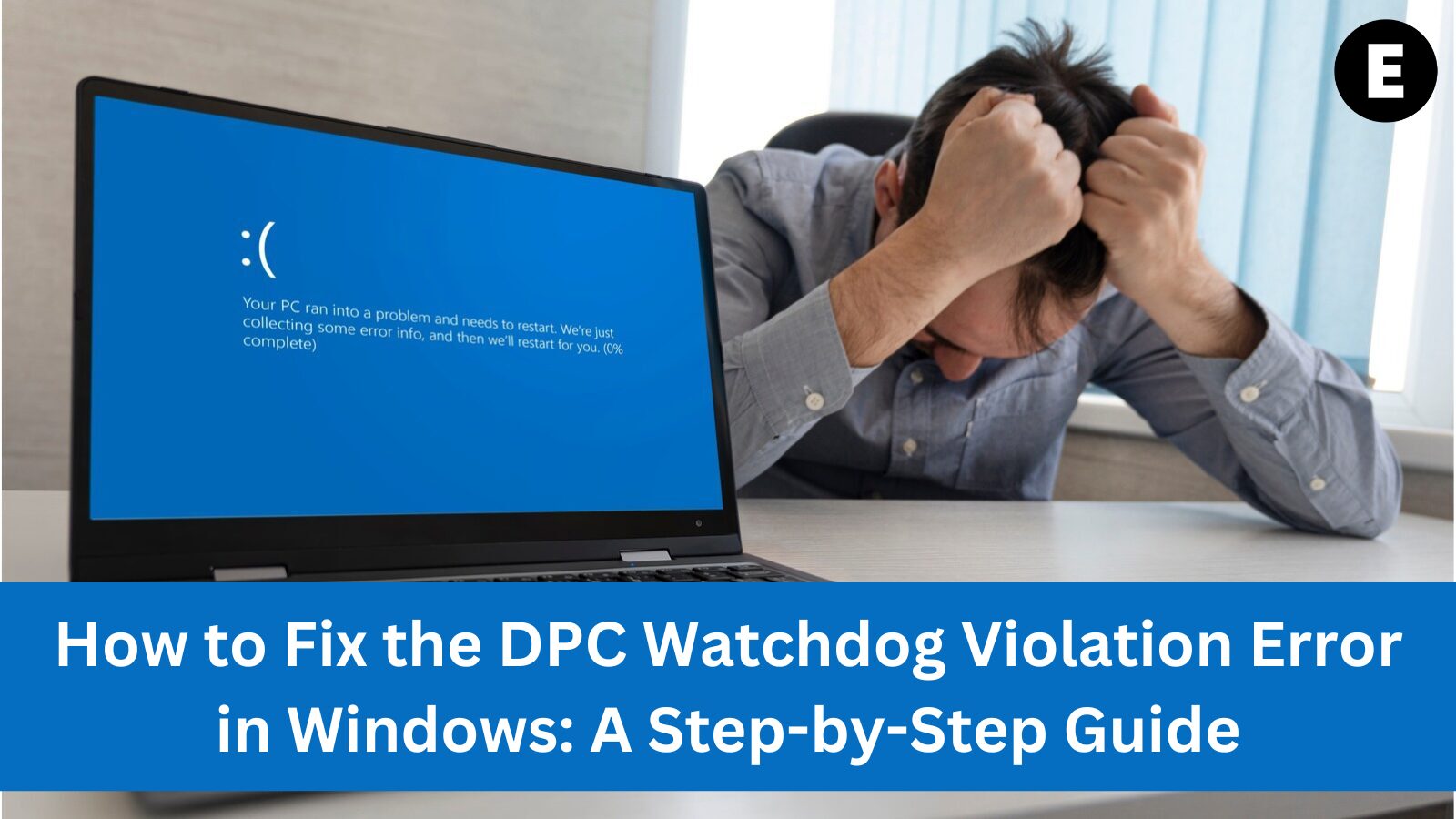The infamous Blue Screen of Death (BSoD) can be a nightmare for Windows users, and one of its most frustrating errors is the DPC Watchdog Violation. When this error occurs, your computer is forced to restart, often leaving you locked out of your system until the problem is resolved. But don’t worry—understanding what causes this error and knowing how to fix it can help you get back to work quickly and efficiently.
What is the DPC Watchdog Violation Error?
The DPC Watchdog Violation is a serious blue screen error that signals a critical issue within Windows. But don’t worry—with the right knowledge, you can resolve it effectively. To begin, let’s break down what this error means.
DPC stands for Deferred Procedure Call, and WATCHDOG refers to the system’s Bug Checker. This error occurs when the Bug Checker takes longer than 100 microseconds to receive a response, triggering a timeout. As a result, your system crashes with a blue screen, potentially causing data loss or trapping you in a frustrating boot loop.
Common causes of the DPC Watchdog Violation error include:
1. Outdated, Corrupt, or Missing Drivers:
Outdated or damaged drivers can disrupt system processes, triggering the DPC Watchdog Violation error. We’ll walk you through how to identify and fix driver-related issues.
2. Hardware Compatibility Issues:
Your computer’s components need to work seamlessly with your operating system. We’ll show you how to detect and resolve hardware compatibility problems.
3. Application and Software Conflicts:
Incompatible or conflicting software can cause system instability. We’ll guide you through troubleshooting and resolving software-related issues.
4. Outdated SSD Firmware:
While Solid State Drives (SSDs) boost performance, outdated firmware can lead to the DPC_WATCHDOG_VIOLATION error. We’ll explain how to update your SSD firmware to prevent this issue.
5. Corrupted or Missing System Files:
Corrupted system files can cause serious problems, including the infamous Blue Screen of Death (BSoD). We’ll introduce you to the System File Checker (SFC) tool, a powerful utility for finding and repairing damaged files.”
Effective Methods to Resolve the DPC Watchdog Violation Error:
In this section, we’ll explore each method to fix the DPC Watchdog Violation error in detail. You’ll find step-by-step instructions and expert tips to help you resolve the issue effectively and prevent it from recurring.
Method 1: Disconnect All External Devices:
External devices like printers, external hard drives, or USB devices can sometimes cause conflicts, triggering the DPC Watchdog Violation error. Here’s how to identify and fix the issue:
- Disconnect All Devices: Safely remove all external devices from your computer, except for your keyboard and mouse.
- Restart Your Computer: After disconnecting, restart your system to check if the error still occurs.
- Reconnect Devices One by One: If the error disappears, reconnect each device individually. Restart your computer after connecting each one to pinpoint the problematic device. If the error returns after reconnecting a specific device, that device is likely the cause.
Method 2: Change the SATA AHCI Controller:
The SATA AHCI controller plays a crucial role in connecting storage devices like hard drives. If it’s misconfigured or outdated, it can cause the DPC Watchdog Violation error. Here’s how to update or change the controller:
- Press Windows Key + X: Simultaneously press t1he Windows key and X key to open the system menu.
- Access Device Manager: From the menu, select “Device Manager.”

- Expand IDE ATA/ATAPI Controllers: Expand the category “IDE ATA/ATAPI Controllers” to view your SATA controllers.
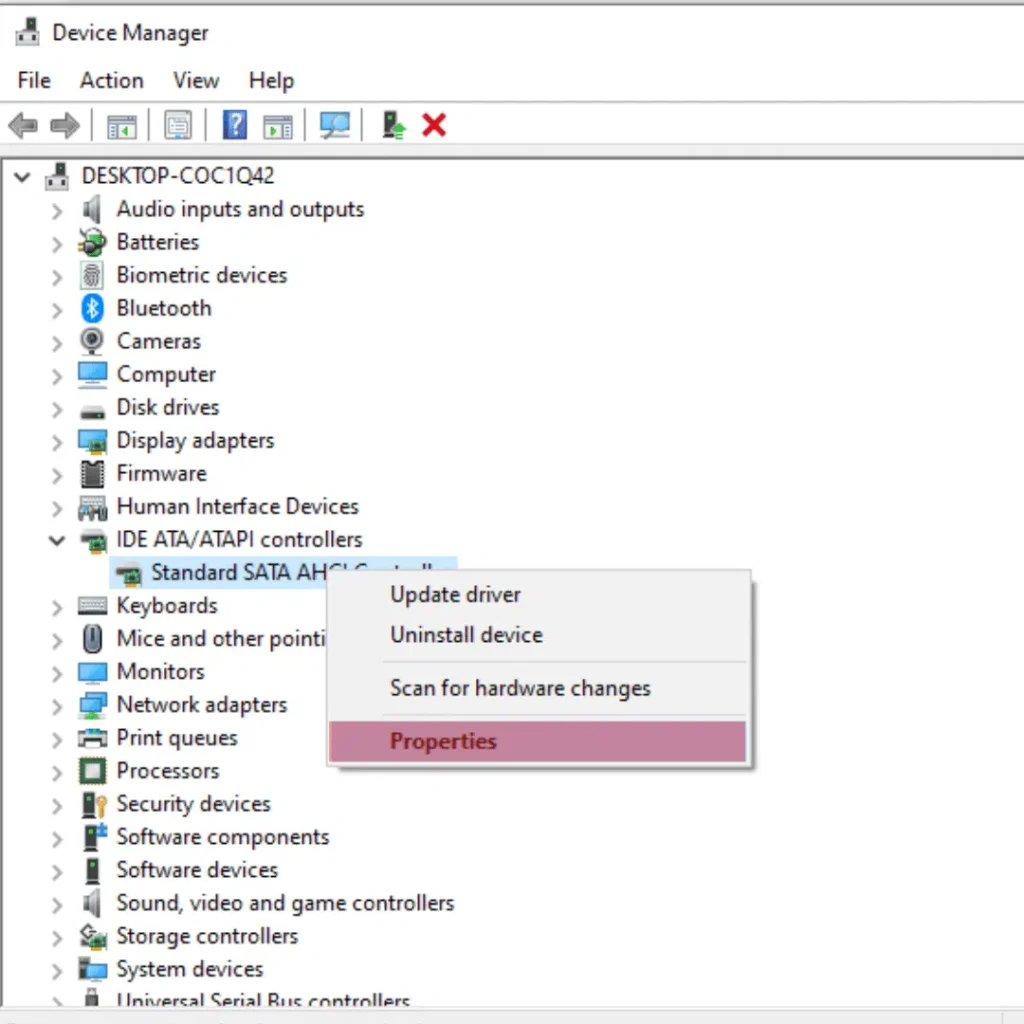
Check for the Correct Controller:
- Right-Click on Each Controller: In the Device Manager, right-click on each controller listed under the IDE ATA/ATAPI controllers category.
- Select “Properties”: From the menu, choose “Properties.”
- Navigate to the Driver Tab: In the Properties window, go to the “Driver” tab and click on “Driver Details.”
- Verify the Driver: Ensure that “iaStorA.sys” is listed as a driver. If it appears, you’re good to proceed with the next steps.
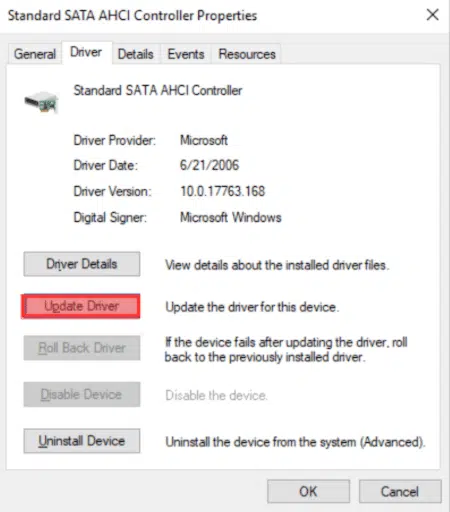
Update the Driver:
- Return to the Driver Tab: Go back to the “Driver” tab in the controller’s Properties window.
- Click “Update Driver”: Select “Update Driver” and choose “Browse my computer for driver software.”
- Select Manual Installation: Click “Let me pick from a list of device drivers on my computer.”
- Choose the Correct Driver: Pick “Standard SATA AHCI Controller” from the list and click “Next.”
- Restart Your Computer: After the installation is complete, restart your system and check if the DPC Watchdog Violation error has been resolved.

Method 3: Update Your SSD Firmware:
If you’re using an SSD, outdated firmware can trigger the DPC Watchdog Violation error. Here’s how to update your SSD firmware:
- Press Windows Key + R: Simultaneously press the Windows key and R key to open the Run dialog.
- Open Device Manager: Type “devmgmt.msc” into the Run dialog and press Enter to launch Device Manager.
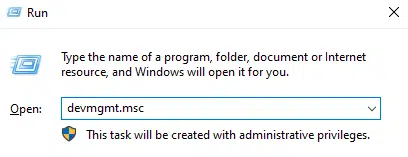
Identify Your SSD:
- Open Device Manager: Expand the “Disk drives” category in Device Manager.
- Note the Model Number: Locate your SSD and take note of its model number.
Visit the Manufacturer’s Website:
- Go to the Manufacturer’s Site: Visit the official website of your SSD’s manufacturer.
- Search for Firmware: Look for the latest firmware update compatible with your SSD model.
Download and Install Firmware:
- Download the Firmware: Download the appropriate firmware file from the manufacturer’s website.
- Follow Installation Instructions: Carefully follow the manufacturer’s guidelines to install the firmware on your SSD.
Method 4: Run the System File Checker (SFC Scan):
Corrupted system files are a frequent cause of the DPC Watchdog Violation error. Fortunately, the System File Checker (SFC) tool can automatically detect and repair these files. Here’s how to run an SFC scan:
- Open Command Prompt as Administrator:
- Type “cmd” in the Windows search bar.
- Right-click on “Command Prompt” and select “Run as administrator.”
- Run the SFC Scan:
- In the Command Prompt, type “sfc /scannow” and press Enter.
- Allow the scan to complete—this process may take some time.
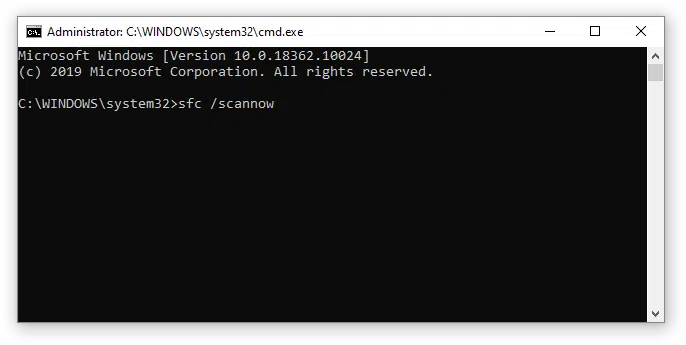
- Restart Your Computer: After the scan is complete, restart your computer.
Running the SFC scan can help identify and repair corrupted system files and potentially fix the DPC Watchdog Violation error.
Method 5: Scan and Repair Disk Errors with CHKDSK:
Disk errors, such as bad sectors, can often cause the DPC Watchdog Violation error. To scan and repair these errors, you can use the Check Disk (CHKDSK) utility. Here’s how:
- Press Windows Key + R: Simultaneously press the Windows key and R key to open the Run dialog.
- Run Command Prompt as Administrator: Type “cmd” in the Run dialog, then press Ctrl + Shift + Enter to open Command Prompt as an administrator.
- Initiate CHKDSK: In the Command Prompt, type “chkdsk C: /f /r /x” and press Enter. Replace “C:” with the drive letter where your Windows installation is located.
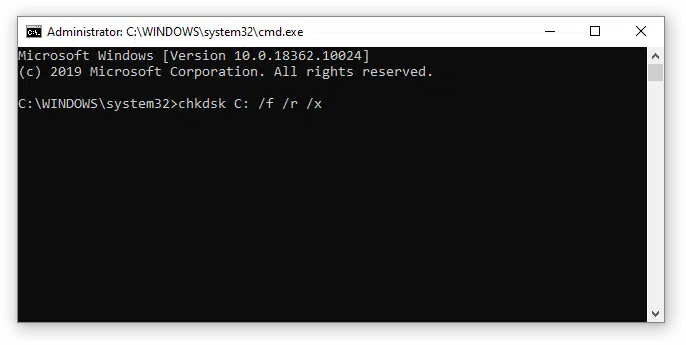
- Confirm the Scan: If prompted, press “Y” on your keyboard to confirm the scan.
- Wait for Completion: Allow CHKDSK to complete the scan and repair process. This may take some time depending on your drive’s size and condition.
- Restart Your Computer: Once the process is finished, restart your system.
Running CHKDSK can help identify and fix disk errors, potentially resolving the DPC Watchdog Violation error and improving your system’s stability.
Method 6: Use the DISM Command to Repair System Images:
The Deployment Image Service and Management Tool (DISM) is a powerful utility designed to identify and repair system-wide corruption issues. It can restore damaged or missing files, making it a valuable tool for resolving errors like the DPC Watchdog Violation. Here’s how to use DISM:
Step 1: Open Command Prompt as Administrator
- Type
cmdin the Windows search bar. - Right-click on Command Prompt and select Run as administrator.
Step 2: Initiate the DISM Scan
- In the Command Prompt, type the following command and press Enter:
DISM.exe /Online /Cleanup-image /Scanhealth - This will scan your system for corruption issues.
Step 3: Execute the Repair Command
- After the scan completes, run the repair command by typing and pressing Enter:
DISM.exe /Online /Cleanup-image /Restorehealth - This will attempt to repair any detected issues.
Step 4: Wait for Completion
- Allow the process to finish. Once done, close the Command Prompt and restart your computer.
Using DISM can help fix system-wide corruption issues, which may be contributing to the DPC Watchdog Violation error and improve your system’s overall health.
Method 7: Remove Newly Installed Software:
Newly installed applications or software can sometimes be incompatible with your operating system or conflict with other programs, triggering the DPC Watchdog Violation error. To resolve this issue, follow these steps:
- Access Control Panel:
- Use the Windows search bar to find and open the Control Panel.
- Change View Mode:
- Change the view mode to “Large icons.”
- Access Programs and Features:
- Click on “Programs and Features.”
- Identify Recent Installs:
- In the list of installed applications, identify any recently installed software. You can click the “Date” column to organize the list by installation date.
- Uninstall New Applications:
- Right-click on the newly installed applications and select “Uninstall.” Repeat this process for each new application.
- Test for Errors:
- After uninstalling, restart your computer and check if the DPC Watchdog Violation error persists.
By removing incompatible or conflicting software, you can often resolve the error and restore system stability.
Method 8: Use the Windows 10 Blue Screen Troubleshooter:
Windows 10 includes a built-in troubleshooter that can help resolve various issues, including the DPC Watchdog Violation error. While this tool won’t recover lost data, it can help prevent future crashes. Here’s how to use it:
- Open the Settings:
- Click on the Windows icon and select “Settings,” or press Windows + I to open Settings directly.
- Access Troubleshoot:
- In the Settings window, click on “Update & Security,” then select “Troubleshoot” from the left pane.
- Run the Blue Screen Troubleshooter:
- Look for the troubleshooter titled “Blue Screen.” If you don’t share full diagnostic data with Microsoft, click on “Additional troubleshooters” and locate the Blue Screen troubleshooter there.
- Start the Troubleshooter:
- Click on “Run the troubleshooter” and follow the on-screen instructions.
- Wait for Resolution:
- Allow the troubleshooter to identify issues and apply fixes. Your computer may shut down and restart during this process. Once completed, check if the DPC Watchdog Violation error reoccurs.
Using the built-in troubleshooter is a simple and effective way to address system errors and improve stability.
Method 9: Reset Windows:
If none of the above methods resolve the DPC Watchdog Violation error, a complete Windows reset may be necessary. Depending on your preference, you can reinstall the operating system without losing personal files, though applications and system configurations will be reset. Here’s what you need to know:
- Keep Personal Files:
- This option reinstalls Windows while preserving your personal files (documents, photos, etc.), but removes installed applications and resets system settings.
- Remove Everything:
- This option performs a full reset, removing all personal files, applications, and settings. It’s a clean slate for your system.
A Windows reset can help eliminate persistent system issues, including the DPC Watchdog Violation error, and restore your computer to a stable state.
Remember to back up your important data before proceeding with a system reset.
A well-detailed and comprehensive description of these methods ensures that you have a clear understanding of how to tackle the DPC Watchdog Violation error effectively. By following these steps, you can troubleshoot the error and regain control of your Windows system. It’s important to remember that these methods address various potential causes, so it’s recommended to start with the one most relevant to your situation and proceed from there.
One more thing
If you’re in search of a software company that embodies integrity and upholds honest business practices, your quest ends here at Ecomkeys.com. As a Microsoft Certified Partner, we prioritize the trust and satisfaction of our customers. Our commitment to delivering reliable software products is unwavering, and our dedication to your experience extends far beyond the point of sale. At Ecomkeys.com, we provide a comprehensive 360-degree support system that accompanies you throughout your software journey. Your trust is our foundation, and we’re here to ensure that every interaction with us is a positive and trustworthy one.

